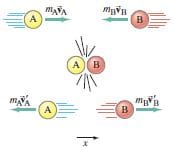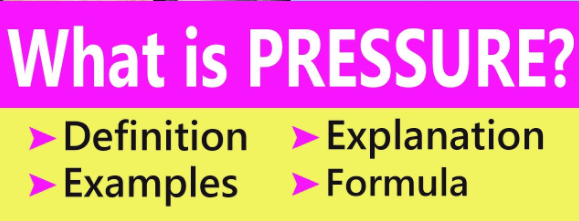Guess now!
- Why do the passengers in the bus move forward when the bus stops quickly?
- What happens when two bodies strike with each other?
- Why gun recoils back after firing?
Do you want to learn these types of questions then?
Let start:
Law of conservation of momentum definition

According to this law: “The momentum of an isolated system of two or more than two interacting bodies remains constant.”The momentum of a system depends on its mass and velocity. A system is a group of bodies within certain boundaries. An isolated system is a group of interacting bodies on which no external force is acting. It is expressed mathematically as:

The above formula states that the momentum of two striking bodies before and after collision remains the same.
Conservation of momentum examples in real life
- Consider the example of an air-filled balloon as described under the third law of motion. In this case, the balloon and the air inside it form a system. Before releasing the balloon, the system was at rest and hence the initial momentum of the system was zero. As soon as the balloon is set free, air escapes out of it possesses momentum. To conserve momentum, the balloon moves in a direction opposite to that of air rushing out.
Similarly:
- A system of guns and a bullet. Before firing the gun, both the gun and the bullet are at rest, so the total momentum of the system is zero. As the gun is fired, a bullet shoots out of the gun and acquires momentum. To conserve the momentum of the system, the gun recoils. According to the law of conservation of momentum, the total momentum of the gun and the bullet will be zero after the gun is fired. Let m be the mass of the bullet and v be the velocity on firing the gun; M is the mass of the gun and V be the velocity with which it recoils. Thus the total momentum of the gun and the bullet after the gun is fired will be:
The total momentum of gun and bullet after the gun is fired = M v + m v ….(1)
According to the conservation of momentum law:
The total momentum of gun and bullet after the gun is fired =Total momentum of gun and bullet before the gun is fired
Therefore we get:
M V +mv = 0
or M V = -m v
Hence:

The above equation gives the velocity V of the gun, the negative sign indicates that the velocity of the gun is opposite to the velocity of the bullet. i .e the gun recoils. Since the mass of the gun is much larger than the bullet, therefore, the recoil is much smaller than the velocity of the bullet.
Example:
A bullet of mass 20 g is fired from a gun with a muzzle velocity of 100 ms-1. The mass of the gun is 5 kg. Then the recoil of the gun will be – 0.4 ms-1. The negative sign indicates that the gun recoils i.e moves in the backward direction opposite to the motion of the bullet with a velocity of 4 ms-1.
Rockets and jet engines also work on the same principle. In these machines, hot gases produced by the burning fuel rush out with large momentum. The machines gain equal and opposite momentum. This enables them to move with very high velocities.
Conservation of linear momentum
“When the net external force acting on a system is zero, the total vector momentum of the system remains constant.”
Suppose that the sum of the external forces acting on a system is zero. Then:
![]()
This simple but quite general result is called the law of conservation of linear momentum. Like the law of conservation of energy, the law of conservation of linear momentum applies to a wide range of physical situations and has no known exceptions.
Conservation laws (such as those of energy and linear momentum), are of theoretical and practical importance in physics because they are simple and universal. The laws of conservation of energy and of linear momentum, for example, go beyond the limitations of classical mechanics and remain valid in both the relativistic and quantum realms.
Why does an ordinary rifle recoil (kick backward) when fired?

Conservation laws all have the following form. While the system is changing there is one aspect of the system that remains unchanged. Different observers, each in a different reference frame, would all agree if they watched the same changing system, that the conservation laws applied to the system.
For the conservation of linear momentum, for example, observers in different inertial reference frames would assign different values of P to the linear momentum of the system, but each would agree (assuming ∑ Fext=0) that the value of P remained unchanged as the particle that makes up the system move about. The force F is invariant with respect to Galilean transformations (all inertial observers agree on its measurements). If ∑ Fext=0 in any inertial frame, then all inertial observers will also find ∑ Fext=0 and will conclude that momentum is conserved.
The total momentum of a system can be changed only by external forces acting on the system. The internal forces, being equal and opposite, produce equal and opposite changes in momentum, which cancel each other. For a system of particles on which no net external force acts:
P1 +P2 +P3+……..+Pn=a constant …..(2)
The momenta of the individual particles may change, but their sum remains constant if there is no external force. Momentum is a vector quantity. Equation 2 is, therefore, equivalent to three scalar equations, one for each coordinate direction.
Hence the conservation of linear momentum supplies us with three conditions on the motion of a system to which it applies. The conservation of energy, on the other hand, supplies us with only one condition on the motion of a system to which it applies, because energy is a scalar.
If our system of particles consists of only a single particle, then equation( 2 ) reduces to a statement that when no net force acts on it the momentum of the particle is a constant, which (for a single particle) is equivalent to stating that its velocity is constant. This is simply a restatement of Newton’s first law.
Three applications of conservation of momentum in daily life
-
Air-filled balloons
In the air-filled balloon, the balloon, and the air inside form a kind of system. Initially, when the system is at rest, the momentum of the system is also zero. As soon as the balloon is set free air escapes out with some great velocity, balloon moves forward in the direction opposite to air rushing out.
-
The system of gun and bullet
Before firing both gun and bullet are at rest, therefore the momentum of the system is zero. When the bullet is fired the bullet moves forward and the gun recoils back. The mass of the gun is very large as compared to the mass of the bullet, therefore the recoil’s velocity is very small as compared to the velocity of the bullet.
-
The motion of rockets and jet engines
Rockets and jet engines also work on the law of conservation of momentum. In these hot gases produced by burning of fuel rush out with large momentum, Due to this, these machines gain an equal and opposite momentum. This momentum enables the rockets and jet engines with very high velocities.
